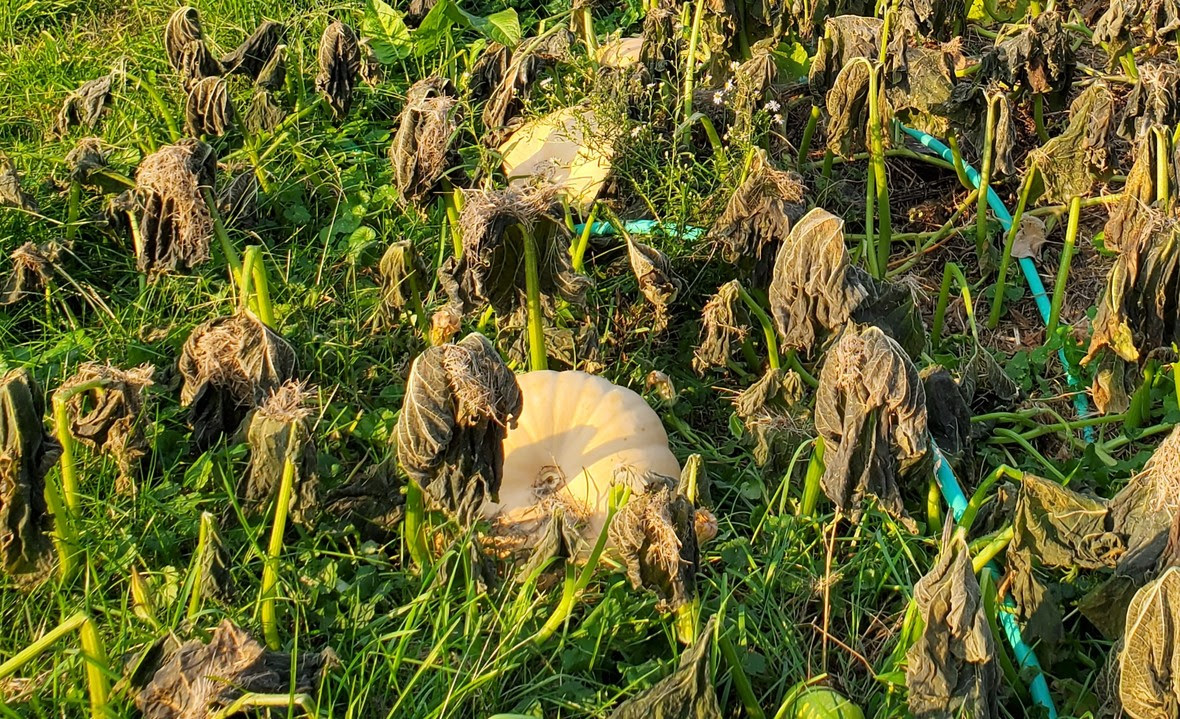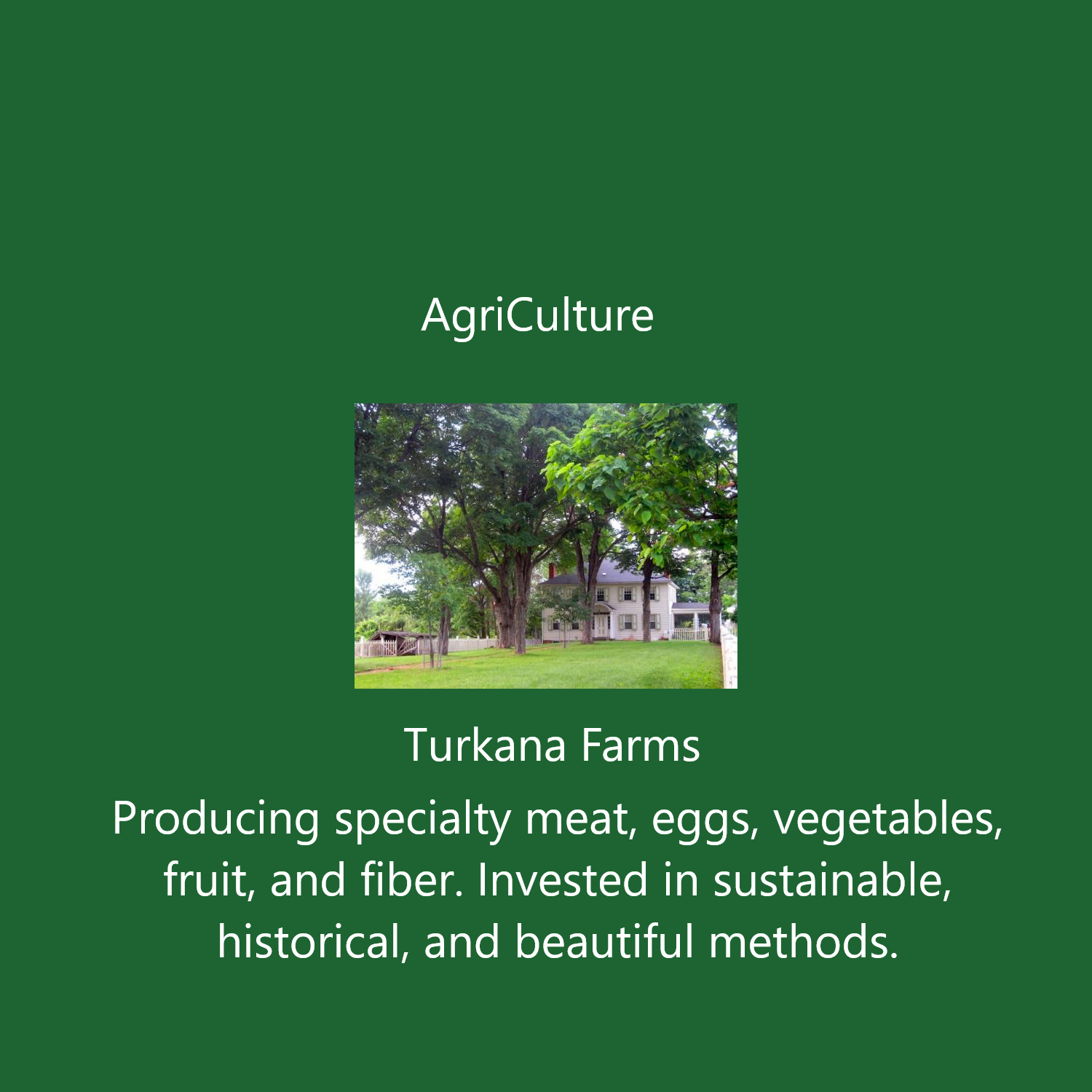
Weather forecasts are a wondrous thing. On a cloudless day without a hint of a breeze they can tell you that in twelve or 24 hours a storm will arrive, with 60 mile an hour winds and hail. They do so with a remarkable degree of precision in the near term.
Forecasts are generally framed in terms of probability, because the likely event is not always the one that happens. Hurricanes veer off. Storms dissolve. Other forces like fires affect the atmosphere with unpredictable consequences. That is, “shit happens.” Yet we are so used to the accuracy of short range forecasts that we get angry with meteorologists whose predictions do not hit the mark.
 Frost killed vines reveal pumpkins below Photo by Mark Scherzer
Frost killed vines reveal pumpkins below Photo by Mark ScherzerMy faith in the weatherman extends even into realms like longer term forecasts where it should be obvious that specific events are unpredictable. This year, when it was unclear to me in planting season where I would be (farm or city) and for how long, I was late getting many seedlings started and plants in the ground. I ultimately decided to go full steam ahead in the garden, relying in part on predictions that La Niña would cause above average temperatures through October. I knew my tomatoes, peppers and cucumbers would start very late, but I figured I’d be hauling them in until Halloween.
The prediction of warm weather on the whole has been accurate. Witness the balmy near 80 degree weather on the last weekend of September. But just as there is a different between overall climate and weather, even a warm spell of weather can have some cold days mixed in. And on two nights this week, we had an uncharacteristically early frost.
I had no warning of the first night of frost. Perhaps I should have seen the predicted nighttime low temperatures in the upper 30s and gone out and harvested and covered plants. But such is my faith in short term forecasts that, without seeing a frost warning, I didn’t think it would happen. Even when I first went out Tuesday morning I did not see that much actual white covering, but I’ve since been told that in drought-like times there may be insufficient moisture in the ground to create that white coating. The damage was still done. By Tuesday afternoon it was apparent that the leaves on all the frost sensitive vegetables had shriveled. Much of the fruit was intact and could be harvested, but the likelihood of new fruit formation this season is virtually nil.
Fall’s brief appearance made visible all the Long Island cheese pumpkins that had been growing partly hidden by the vines. It caused me to rush a load of fresh straw down to our pigs, so Possum could make a cozy nest for herself and Vernon inside their hut. Yet despite this illustration of the unpredictability of weather more than a few days into the future, my faith in the weatherman was apparently unshaken.
Later the day of the frost I found myself studying in detail a series of maps illustrating the likely effects on this region of climate change in the period 2040 to 2060. The maps were in a Pro Publica article, “New Climate Maps Show a Transformed United States” , to which I was linked by an excellent article in the New York Times, “How Climate Change will Reshape America” My focus on these maps was in some sense absurd. I was hoping they would inform my immediate decisions about my future with the farm, even though they are predicting conditions in the years when I will be (should I live so long) 89 and 109 years old, respectively.
My friend George pointed out the other day that if it’s Monday I am probably intent on giving up my New York apartment and making the farm my full time permanent residence, but if it’s Tuesday I’ve decided I must take advantage of the strong real estate market and sell the farm to secure my financial future. By Wednesday I’ve decided to straddle the two worlds as I have been. Nonetheless, I keep looking for the kernel of information will show me what the right decision is.
In this case, the maps were predicting where Americans would have to move to live bearable lives in the future. A team of researchers had modeled the human climate “niche”: the regions where temperature and precipitation have been most suitable for humans to live over the past 6,000 years. The temperate, productive niche where humans can best make a go of it covers much of the middle of the country now. As the climate changes, the human niche will shift north and toward the midwest, in the most extreme scenarios centering on south central Canada, and large swaths of the southeast and southwest will become almost uninhabitable. More than half the days in Arizona will see highs above 95, with many “wet bulb” days when the high temperature plus humidity will make it dangerously difficult for the body to cool down. Agricultural yield in parts of Texas and Oklahoma will drop by 70 to 90%, and gross domestic product will drop dramatically in the southeast. The moderate verdant climate of the North Carolina piedmont that so many New Yorkers these days seek out in retirement will be found in Vermont.
When I looked through the maps for what will become of Columbia County, I was pleased to find that under all scenarios we remain in the verdant human niche. We will have a few more “wet bulb” days, but still fewer than five a year. Unlike New York City, hardly any of our land will be underwater at high tide. Our crop yields will actually increase between 6 and 15%. The effect of climate change on our gross domestic product will be more or less neutral.
If, as the Times article predicts, Americans will be migrating to the areas that remain habitable, it’s a good bet that what has become prime real estate here in the age of COVID will be even more relatively valuable 20 years from now. I decided I should hold on to the farm.
Then again, as George might have predicted, by the end of the week I had new information that upset my calculations again. How can I make a decision based on what the climate will be like 20 years from now when I don’t even know what country I’ll be living in come January? Dan Balz in the Washington Post (“This is not a drill. The Reichstag is burning.”) elegantly outlined the parallels between the way President Trump is seeking to undermine the democratic process and the way Hitler came to absolute power in Germany. Will I be governed by the Constitution of the United States of America or will I be under the thumb of a legislatively anointed President for Life on the model of Papa Doc Duvalier (Haiti) or Saparmurat Nyazov (Turkmenistan)?
I must give credit to my prescient sister, Jolie, who saw this coming four years ago. She didn’t need a weatherman to know which way the wind blows
Possum in the Straw

WHAT’S NEW THIS WEEK:
FROST KILLED THE TENDER STUFF. An early end to our late start on peppers, tomatoes (that were just ripening), cucumbers, beans and squash.
But the fall loving crops are doing fine. Escarole is thriving and will b ready in a couple of weeks. Collard greens, $2/bunch, is ready. And Spanish black radishes, in a second wave, are back. $2/bunch or for any very large single ones.
WHAT’S AVAILABLE THIS WEEK
Small White turnips, $3/bunch
Collard greens, $2/bunch
Large black Spanish Radishes, $2 each (or smaller ones in bunches)
Kale, (curly leaf or lacinato) $2/bunch
Swiss Chard, $3/bag
Fresh dug horseradish root, $3/lb.
Sorrel, one gallon bag, $3/bag
Mint, $1/ bunch
Garlic chives (the flat kind), $1/bunch
EGGS: $5/doz
MEATS:
LAMB: fresh back from processing, Legs of lamb and loin chops, $14/lb, boneless lamb shoulder and shoulder steaks, $10/lb, Ground lamb, $7/lb. For the Central Asians among you, lamb tails, $5/lb.
PORK: fresh ham roasts (2 to 3 lbs), $12/lb
CHICKENS: They were quite uniform in size, all just around 6 lbs, a few under. We’ve already had one and the freedom rangers have been what you want them to be, deeply flavorful. They are now frozen. $6/lb. Separately, bags of chicken livers, also $6/lb.
FARM PICKUPS:
Email us your order at [email protected], and let us know when you’d like to pick up your order. It will be put out for you on the side screened porch of the farmhouse (110 Lasher Ave., Germantown) in a bag. You can leave cash or a check in the now famous pineapple on the porch table. Because I’m now here full time, we’re abandoning regular pick-up times. Let us know when you want your order any day between 10 and 5, and unless there are unusual circumstances we’ll be able to ready it to your convenience. If you have questions, don’t hesitate to call or text at 917-544-6464 or email.

A neighbor was late for his tour of the farm. And he seemed like such a responsible fellow! We had arranged the meeting a...

Turkana Farms, LLC, is a small-scale producer of heritage breed livestock and a wide array of vegetables and berries on just over 39 acres...

Share this:TwitterFacebookEmailLike this:Like Loading...